About This Release
Released - November 12, 2024
In this version of Analytics for LS Central the focus has been on the new Bookings Analytics report and preparation for Analytics support of Aggregate Inventory. The new Bookings report provides a framework for the user to model and analyze bookings and activity reservations data. This report's pages offer an array of analysis suggestions for bookings trends over time, activities revenue, members classification, and resources performance. In addition, a new report dataset items summary page has been introduced to improve the accessibility to the report's semantic model composition.
This version of Analytics supports versions 19.0 and later of LS Central On-premises and later versions of LS Central SaaS. Setup of Analytics for LS Central SaaS needs some additional setup from the standard Analytics onboarding process and is explained in detail in the onboarding documentation.
If you have older versions of LS Central or NAV, some parts of Analytics data warehouse and reports might run, but some of the ETL pipelines will fail to run because of missing tables and columns. We have therefore created a special page in the online help where you can learn more about partial loading of the data warehouse.
Note: Updates for version 2024.1 are provided in a special update package. If you have already set up version 2024.1, you can update to 2024.2 without creating a new instance of Analytics. See update guidelines for more information.
Note: If you have customizations in your Analytics instance, you need to make sure before you start that the updates do not affect these customizations.
The following is a list of changes and key features in Analytics version 2024.2.
New or Enhanced Features
Setup
Product package
Prestaging table creation scripts
Prestaging scripts have been added to for the following LS Central tables:
- LSC ACT Package Offer Line
- LSC ACT Resource Utilization
- LSC Activity Additional Item
- LSC Activity Location
- LSC Activity Product
- LSC Activity Reservation
- LSC Activity Resource Capacity
- LSC Activity Resource
- LSC Activity Type
- LSC Product Additional Item
- LSC Reservation Transaction
- LSC Reservation
- LSC Resource Reservation
Scheduler job header file
The Scheduler header file has been updated to include subjobs for the new prestaging tables:
- LSC ACT Package Offer Line
- LSC ACT Resource Utilization
- LSC Activity Additional Item
- LSC Activity Location
- LSC Activity Product
- LSC Activity Reservation
- LSC Activity Resource Capacity
- LSC Activity Resource
- LSC Activity Type
- LSC Product Additional Item
- LSC Reservation Transaction
- LSC Reservation
- LSC Resource Reservation
An alternative scheduler job header file was also created Scheduler Job Header LSC25.json. In this file we have created subjobs with replication counters for the following tables, and they have been added to the INS_NORMAL_COUNT instead of the subjobs without counter that were added to the INS_NORMAL_FULL job. This was possible because replication counters were added to these tables in version 25 of LS Central.
- LSC Din. Area Plan Statistics
- LSC Din. Reserv. History Entry
- LSC Dining Table History Entry
- LSC Din. Tbl. Hist. Entry Arch
- LSC Din. Tbl. Rcpt. Entry Arch
- LSC Dining Table Receipt Entry
- LSC Din Tbl Hist Entry Res Arc
- LSC Din. Tbl. Hist. Entry Res.
Deployment
No changes were made to the deployment process.
Documentation
Added a page to the online help about running Analytics with LS Central versions older than 19.0.
Added a page to the online help about an alternative third-party solution to replication with Data Director for Analytics with LS Central SaaS and how to use it as a source for a new Analytics environment.
Azure Data Factory
Pipelines
Three new pipelines were added to the standard fact pipelines module in Bicep:
- PL-SP-factActivityReservation
- PL-SP-factActivityResourceReservation
- PL-SP-factActivityResourceUtilization
Data Warehouse
Database
Tables
A new line was added to the LSInsight$PublisherAffix table for the:
- Business Foundation app (F3552374-A1F2-4356-848E-196002525837 )
- We needed to do this because Microsoft are moving tables from the Base Application to the Business Foundation app.
Three new dimension tables were added:
- dActivityProduct
- dActivityLocation
- dActivityResource
Three new fact tables were added using the listed staging tables:
- fActivityReservations
- fActivityResourceReservations
- fActivityResourceUtilization
- For this table to be populated correctly, it is necessary to either:
- Create and run a scheduler job with codeunit 10015889 - LSC ACT Utilization Process on a daily basis.
- Or execute the process manually from the Activity Setup page by selecting the BI Utilization option in the action menu, and then More Options - Actions - Run process from the Resource Utilization BI Worktable page menu.
- Note: This feature was released with LS Central version 25, so it is not available in older versions.
- For this table to be populated correctly, it is necessary to either:
As preparatory work for future Aggregated Inventory feature, three columns were added to dLocation table:
- AggrActive
- AggrLocationType
- AggrLocationCode
One new column was added to fInventory:
- SK_AggregateLocation
Stored procedures
Three new stored procedures were added for loading of data to the new dimension tables:
- dimMergedActivityProductExec
- dimMergedActivityLocation
- dimMergedActivityResource
Three new stored procedures were added for loading of data to the new fact tables:
- factActivityReservation
- factActivityResourceReservation
- factActivityResourceUtilization
As preparatory work for future Aggregated Inventory feature and to guarantee compatibility with older versions, four new procedures were added:
- factAggregatedInventoryFullLoad
- factInventoryExec
- factInventory
- factAggregatedInventory
One procedure was altered:
- dimMergedLocation, in order to detect if Aggregated Inventory is installed and to choose the correct version to be run.
Reports
Bookings Analytics
Within this release we are pleased to present our new deck of report pages for Bookings Analytics .
This report is composed by multiple report pages, offering both an overview and deeper analysis of the data for activity reservations.
This varied set of reports provides a wide range of business insights. Here, business analysts can find trends over time for bookings and activities, analyze revenue, investigate members' demographics, evaluate the traffic coming from different booking channels, and perform assessments over resources distribution and utilization.
For user convenience, a section has been added to present in an easily accessible manner the report dataset items (measures, tables, relationships), that constitute the report's semantic model.
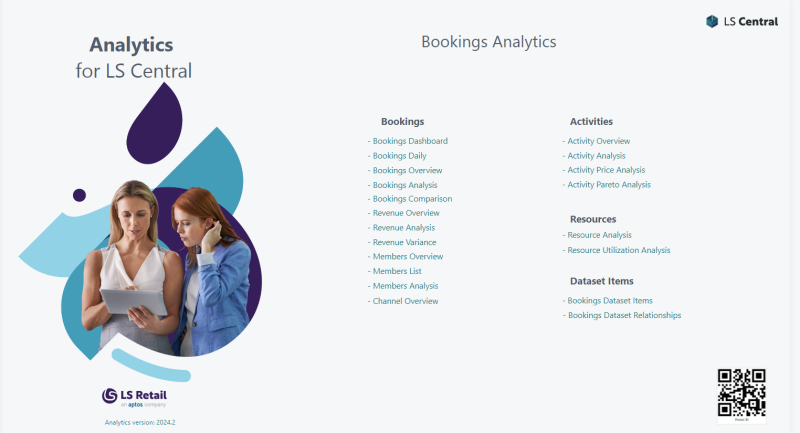
Bookings
The first section in the report Navigation page is Bookings. This chapter consists of a comprehensive set of pages that provide valuable business insights over bookings, activity reservations data, and trends.
The initial Bookings Dashboard provides a valuable overview of the business results across different KPIs and a quick insight on its performance over the months of the year.
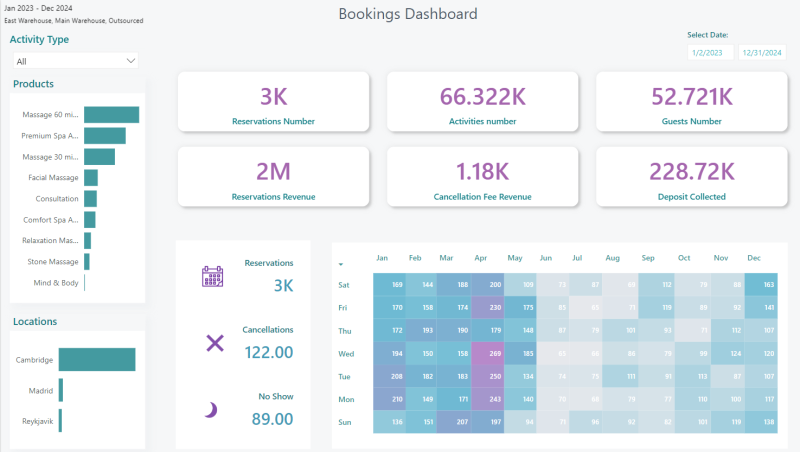
By contrast, the Bookings Daily dashboard offers the "operational picture", allowing immediate information to be obtained for the smooth running of daily front-end operations and consultations.
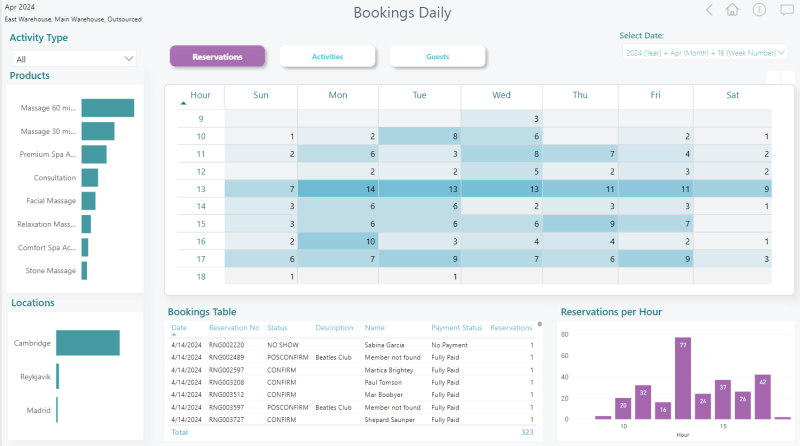
Further customer and member knowledge can be extracted and analysis delineated upon demographic data and customer segmentation details. By derivation from the analysis, proactive action can be taken with the support of fast retrieval of customer listings and their respective contact details.
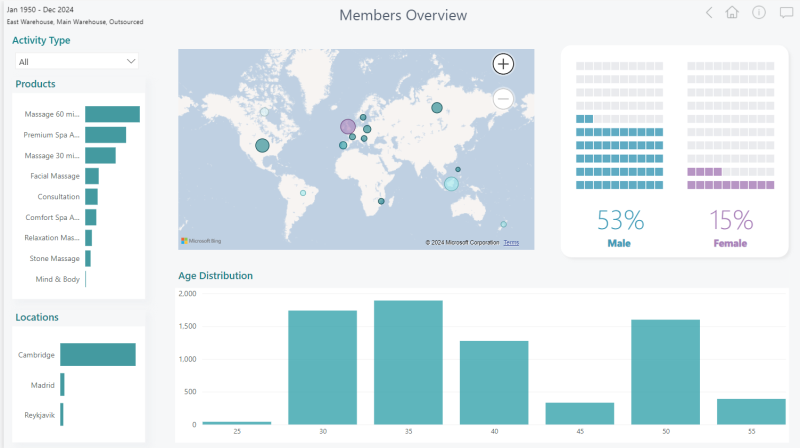
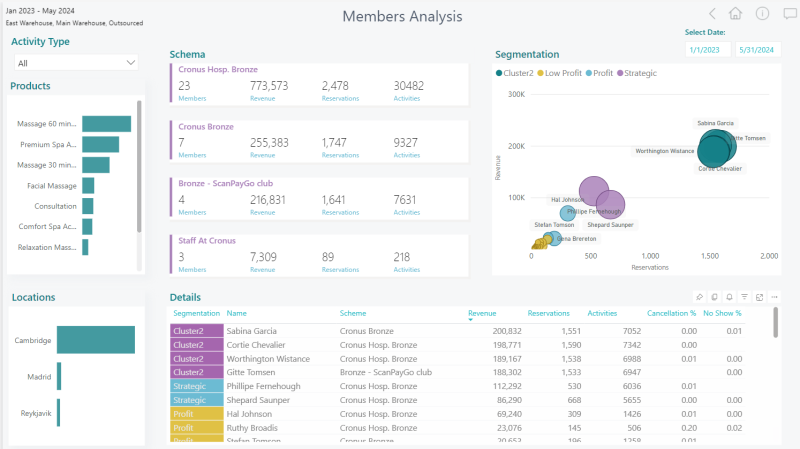
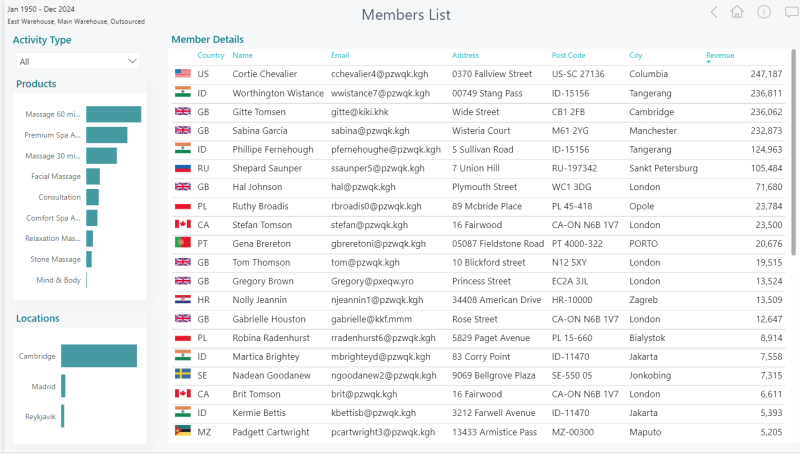
Activities
Under this Bookings report chapter the user can dive into the specifics for activities data. Here, we offer the business analyst the area to compare the results over time, assess pricing strategy, and tap into insights for which activities have the most desirable impact in the business outcome.
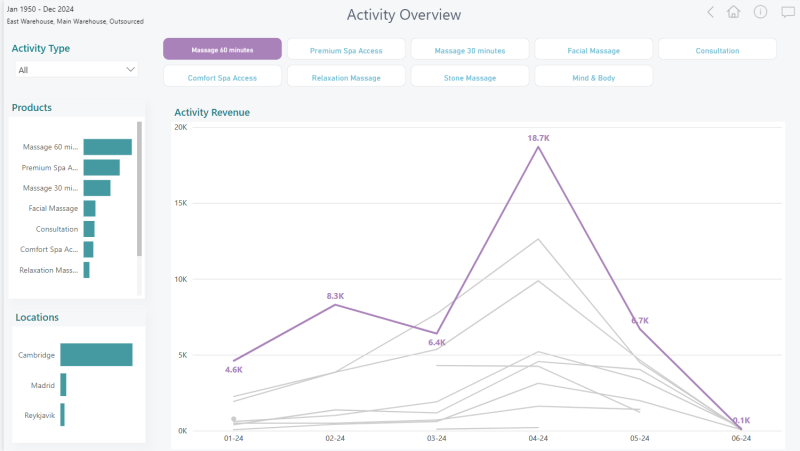
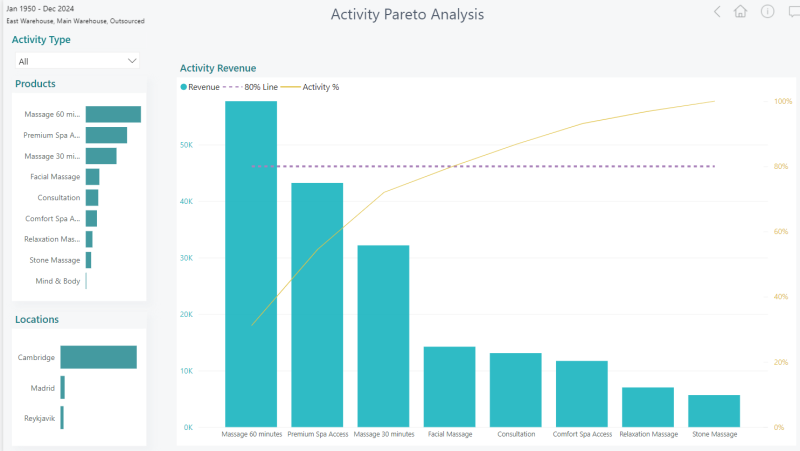
Resources
Attention is given at the Bookings report into performance and time allocation tracking for different resources in the business, on a monthly and weekly basis.
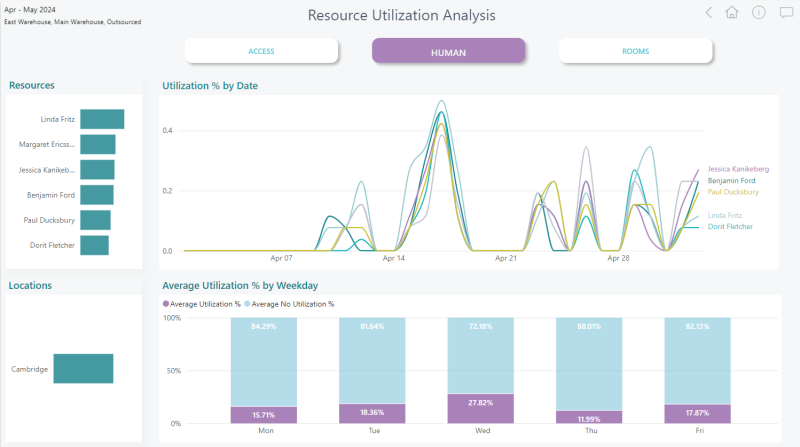
Dataset Items
Within this report, opportunity has been taken to introduce a simplified manner to access the report's semantic model elements. All measures, dimension and fact tables, as well as their respective relationships, can now be easily found and consulted at the last report pages.
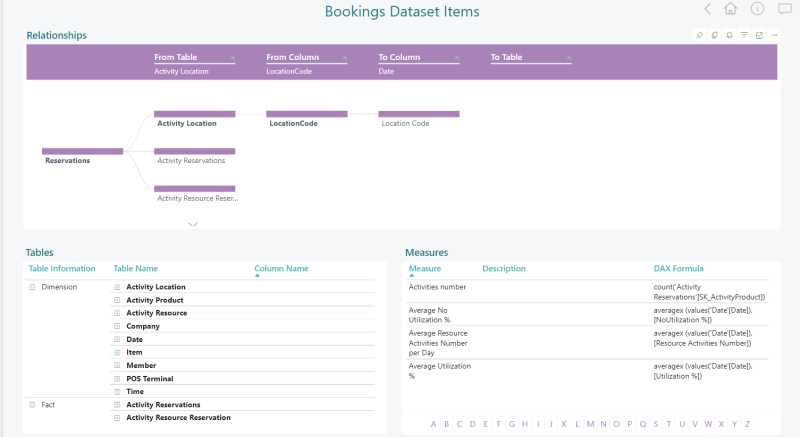
Bug fixes
Data warehouse
In order to retrieve the Posting Group value, a join between SK_BusinessPostingGroup and SK_ProductPostingGroup was added for Trans Sales Entry rows.
Reports
There are no new bug fixes to be communicated in this release.